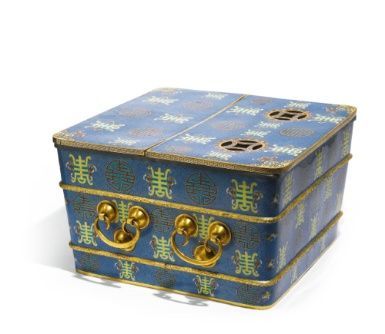A Rare Cloisonné Enamel Ice-Chest and Covers, Qing Dynasty, Qianlong Period
A Rare Cloisonné Enamel Ice-Chest and Covers, Qing Dynasty, Qianlong Period - Photo Sotheby's
of square form, the tapering sides divided into three horizontal sections by two raised gilt ribs chased with floral scrolls, flanked by pairs of C-shaped handles, the body decorated with stylised shou characters flanked by pairs of bats alternating with shou character roundels, all reserved on a T-diaper ground, the two removable flat covers similarly decorated with one section pierced with two cash coins, the interior lined with wood and pewter. Quantité: 6 - 60 by 61 by 37cm., 23 5/8 by 24 by 14 1/2 in. Estimation: 100,000 - 150,000 GBP
PROVENANCE: Collection of Count Johann Henrich von Bernstorff.
Collection of Edgar Worch, Berlin.
Collection of Kaufman, Berlin, until 1923.
Collection of Paul Bernheimer, Boston.Collection of Grace Kaler, Maine.
Christie’s Hong Kong, 29th April 2001, lot 578.
NOTE DE CATALOGUE: The present cloisonné enamel ice-chest is impressive for its magnificent size and superb quality of enamelling and workmanship. Chests of this type were made in sections separated by horizontal divisions, two handles at each end and hinged covers with two pierced apertures on the top. A related imperial ice-chest can be found in the Palace Museum, Beijing; for example see a comparable piece illustrated in The Complete Collection of Treasures of the Palace Museum. Metal-bodied Enamel Ware, Hong Kong, 2002, pl. 129, decorated with large stylized passionflowers on a similar blue-ground in vivid enamels. Another cloisonné enamel ice-chest was sold at Christie’s New York, 20th October 2004, lot 601, from the C. Ruxton and Audrey B. Love collections; and a pair was also sold at Christie’s New York, 20th September 2005, lot 123, where it is mentioned that 18th century ice-chests destined for the apartments of those other than the emperor were made of plain bronze lined with pewter. This piece would have been intended for use in the private residence of the emperor and his family.
Ice-chests were an important part of the palace furnishing. They were not only functional but decorative at the same time. They had two practical uses; in the hot summer months food, beverages, fruit and snacks were placed on top of the ice inside the chest for cooling. They were also used for releasing cool air into the surrounding rooms and hallways. The two apertures on the cover allowed cold air to escape, while the thick walls of the chest helped maintain the interior temperature. Craig Clunas in Chinese Furniture, London, 1988, p. 100, mentions that ice used in the palace was stored in large underground pits during the winter, to be broken up and kept in these special chests in hot weather. He illustrates a wooden chest of this form, in the Victoria and Albert Museum, London, ibid., pl. 89, lined with lead.
Sotheby's. Treasures of the Qing Court, A Personal Perspective. London | 07 nov. 2012, www.sothebys.com

/https%3A%2F%2Fprofilepics.canalblog.com%2Fprofilepics%2F1%2F0%2F100183.jpg)
/https%3A%2F%2Fstorage.canalblog.com%2F03%2F02%2F119589%2F96711876_o.jpg)
/https%3A%2F%2Fstorage.canalblog.com%2F11%2F31%2F119589%2F94773502_o.jpg)
/https%3A%2F%2Fstorage.canalblog.com%2F20%2F83%2F119589%2F94772815_o.jpg)
/https%3A%2F%2Fstorage.canalblog.com%2F26%2F72%2F119589%2F75604929_o.jpg)
/https%3A%2F%2Fstorage.canalblog.com%2F59%2F60%2F119589%2F26458628_o.jpg)





/http%3A%2F%2Fstorage.canalblog.com%2F98%2F98%2F119589%2F129097971_o.jpg)
/http%3A%2F%2Fstorage.canalblog.com%2F93%2F75%2F119589%2F128489120_o.jpg)
/http%3A%2F%2Fstorage.canalblog.com%2F09%2F29%2F119589%2F128488304_o.jpg)
/http%3A%2F%2Fstorage.canalblog.com%2F62%2F18%2F119589%2F128488091_o.jpg)